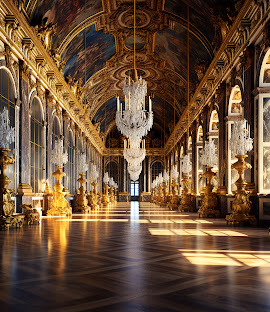Palace of Versailles, France
The Palace of Versailles: A Monument to Royal Grandeur
The Palace of Versailles, located just outside Paris, is one of the most magnificent and historically significant palaces in the world. This UNESCO World Heritage site draws millions of visitors annually to explore its opulent architecture, extensive gardens, and storied history.
Key Highlights 🏰
-
Hall of Mirrors: This iconic room is a masterpiece of French Baroque architecture, where the Treaty of Versailles was signed to end World War I. The hall is lined with mirrors that reflect the beautiful gardens outside.
-
Château de Versailles: Originally a hunting lodge, King Louis XIV transformed the modest property into an extravagant palace. The château features grandiose rooms, including the King’s Grand Apartments and the Royal Chapel.
-
Gardens of Versailles: Designed by André Le Nôtre, the palace gardens are a stunning example of French formal garden design, with sprawling lawns, fountains, and meticulously planned pathways.
Historical Significance 🏛️
-
Louis XIV: The Sun King, Louis XIV, made Versailles the seat of French power, turning it into the symbol of absolute monarchy. The palace represents his vision of grandeur and centralized royal authority.
-
French Revolution: Versailles played a pivotal role in the French Revolution. The palace was stormed by revolutionaries in 1789, marking a turning point in France’s history.
-
Treaty of Versailles (1919): After World War I, the Treaty of Versailles was signed in the Hall of Mirrors, officially ending the conflict and reshaping Europe’s political landscape.
Must-See Areas in the Palace 🌟
-
The Royal Apartments: The rooms where the King and Queen resided are ornate and richly decorated. These rooms reflect the opulence of the French monarchy, featuring luxurious furniture and gilded details.
-
The Gardens: The vast gardens are not only beautiful but also host grand fountains and sculptures, such as the Fountain of Apollo, representing the Sun King’s association with the sun god.
-
The Grand Trianon: A more intimate and serene space, this smaller palace was built by Louis XIV for his personal use and to escape the grandiosity of the main palace.
Practical Information 💡
-
Opening Hours: The Palace is typically open every day except Mondays and certain holidays. It’s recommended to check for any special closures before planning a visit.
-
Tickets: Entry tickets vary depending on whether you want access to just the palace or the entire estate, including the gardens and Trianons.
-
Getting There: Versailles is easily reachable from Paris via the RER C train line, taking about 40 minutes from central Paris.
Ratings and Visitor Feedback 🌟
Overall Rating: 9.7/10
-
Historical Significance: 10/10
-
Architecture and Design: 9.9/10
-
Gardens and Grounds: 9.8/10
-
Visitor Experience: 9.6/10
Best Time to Visit ⏰
The best time to visit is during spring (April to June) or autumn (September to November). The weather is mild, and the gardens are in full bloom. Summer can be crowded, so it’s better to plan your visit early in the morning or later in the afternoon.


